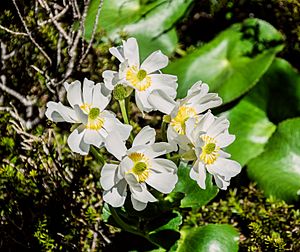Mountain buttercup facts for kids
Quick facts for kids Mountain buttercup |
|
|---|---|
 |
|
| Scientific classification | |
| Genus: |
Ranunculus
|
| Species: |
lyallii
|
The Mount Cook buttercup (Ranunculus lyallii) is a very special plant. It is the largest buttercup in the world! You can only find it in New Zealand, especially in the South Island and on Stewart Island. It grows high up in the mountains, usually between 700 and 1,500 meters above sea level. People sometimes call it the 'Mount Cook lily' because its big white flowers look a bit like lilies, even though it's actually a buttercup.
Contents
About the Mount Cook Buttercup
This amazing plant is a perennial. This means it lives for many years, unlike plants that die after one or two seasons. It can grow quite tall, reaching between 60 and 100 centimeters (about 2 to 3 feet) high. It has a thick underground stem called a rhizome. This helps the plant store energy and grow back each year.
What the Plant Looks Like
The Mount Cook buttercup has shiny, dark green leaves. They are very large, often 15 to 40 centimeters (6 to 16 inches) wide. What makes them unique is their shape: they are peltate. This means the leaf stem is attached to the middle of the leaf, not just the edge, like an umbrella.
The flowers are also very impressive. They are large, about 5 to 8 centimeters (2 to 3 inches) across. Each flower has 10 to 20 bright white petals. In the center, you'll see many yellow stamens, which are the parts that produce pollen. These beautiful flowers bloom from late spring to early summer.
Where the Mount Cook Buttercup Grows
This unique buttercup is found only in New Zealand. It thrives in the alpine areas of the South Island and on Stewart Island. You can see many of these plants in places like Aoraki/Mount Cook National Park. They also grow in other mountain regions, including the area around Arthur's Pass. These plants are endemic to New Zealand, meaning they naturally grow nowhere else in the world.
How It Was Discovered
The Mount Cook buttercup was first found by a Scottish botanist and doctor named David Lyall. He lived from 1817 to 1895. Another famous botanist, Sir Joseph Dalton Hooker, wrote about this plant in his book Flora Antarctica. He called it "the monarch of all buttercups" because of its huge white flowers. Hooker also noted that it was the only known buttercup with those special peltate leaves. New Zealand shepherds even called it the 'water-lily' of the mountains.
Cultural Significance in New Zealand
The beautiful Mount Cook buttercup is more than just a plant; it's a symbol in New Zealand.
- Airline Logo: For many years, the flower was the logo for Mount Cook Airline. It was a well-known symbol until the airline became part of Air New Zealand in 1989.
- Postage Stamps: This iconic flower has appeared on New Zealand Post stamps many times. It was first featured as early as 1936. Since then, it has been part of stamp collections celebrating New Zealand's conservation efforts and stunning scenery.

